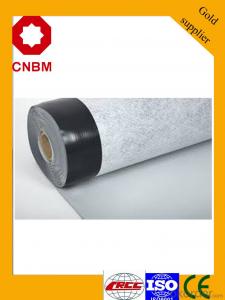SBS Self-adhesive Bituminous Waterproof Roofing Membrane
- Loading Port:
- Shanghai
- Payment Terms:
- TT OR LC
- Min Order Qty:
- 44 roll
- Supply Capability:
- 100000 roll/month
OKorder Service Pledge
OKorder Financial Service
You Might Also Like
Product description
SBS modified bitumen waterproof membranes use high quality needle punched polyester mat or fiberglass compound mat as the base reinforcement. And use SBS modified bitumen as the dip-coat material. The SBS modified bitumen waterproof membrane are widely used for roof waterproof projects.
Specifications
1. Width: 125px-1m or as customized
2. Length: 3m/5m/10m/15m/20m or as customized
3. Thickness: 2mm/3mm/4mm/5mm
4. Surface: PE film, Colorful Sand, Mineral Granules or Aluminium foil
Technical Parameters
No. | Item | Index | |||||
I | II | ||||||
PY | G | PY | G | PYG | |||
1 | Solvend content(g/m²)≥ | 3mm | 2100 | - | |||
4mm | 2900 | - | |||||
5mm | 3500 | ||||||
Experiment phenomena | - | Carrier non-ignitable | - | Carrier non-ignitable | - | ||
2 | Heat risistance | °c | 90 | 105 | |||
≤mm | 2 | ||||||
Experiment phenomena | Non flow,dippage | ||||||
3 | Cold bending/°c | -20 | -25 | ||||
No crack | |||||||
4 | Waterproof 30min | 0.3MPa | 0.2MPa | 0.3MPa | |||
5 | Tensile strength | Maximum peak tensile(N/50mm)≥ | 500 | 350 | 800 | 500 | 900 |
Inferior peak tensile (N/50mm)≥ | - | - | - | - | 800 | ||
Experiment phenomena | In stretching process,the test specimen has no asphalt cracks or separate with the carrier | ||||||
6 | Elongation | Maximum peak elongation | 30 | - | 40 | - | - |
Inferior peak elongation | - | - | 15 | ||||
Product Feature
1. SBS modified bitumen waterproof membrane has good watertightness.
2. SBS modified bitumen waterproof membrane is high strength of extension, good ductility
3. SBS modified bitumen waterproof membrane is special used for low temperature.
4. SBS modified bitumen waterproof membrane is easy construction, can be constructed all of the year by the way of hot melt.
Application
1.Make sure the roof deck is smooth,clean and dry(Moisture<9%),then apply the surface of roof deck with a kind bitumen paint till dry.
2. There are two methods in application:
One way is by heating and melting method---Heat the membrane and roof deck surface by heating and melting method to be nearly melted(not flowing),then install the membrane fully bonded to the roof deck with overlaps of 5-250px.
The other way is by cold adhesive method---Pour the cold adhesive on the roof deck then roll the membrane to install it to be fully sticked to roof deck.
By heating and melting method and by cold adhesive can be used in alternation as requested.
3.After application,, a full serious inspection is required,that’s to make sure no air bubble,,no fold,,no falling away etc. and guarantee the waterproof life.
Requirements for construction
1.The base should be dry and clean. Do not work in the rainy or snowy day.
2.Do not work under heavy wind(above 5 grade)
3.Unsuitable for construction below 5°C
4.If it is rain or snow in the process of construction, protective measure to the laid membrane is must.
5.All the workers should put on special uniforms to keep safe when installing. There should be equipments for fire controls.
product show

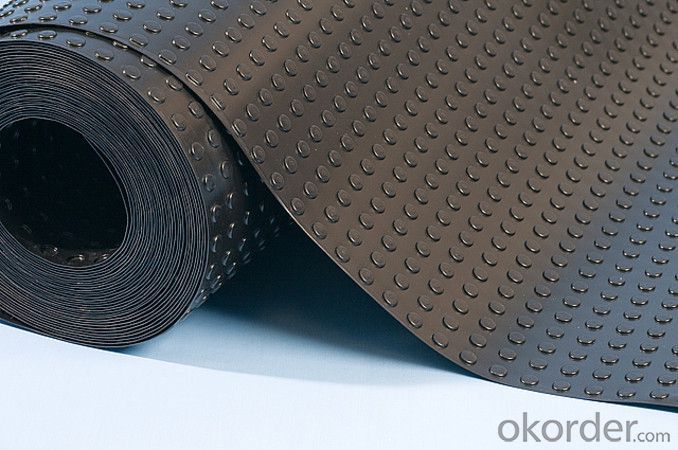

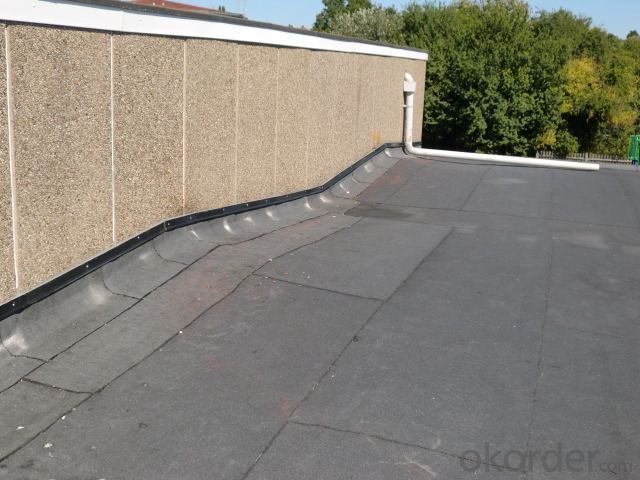
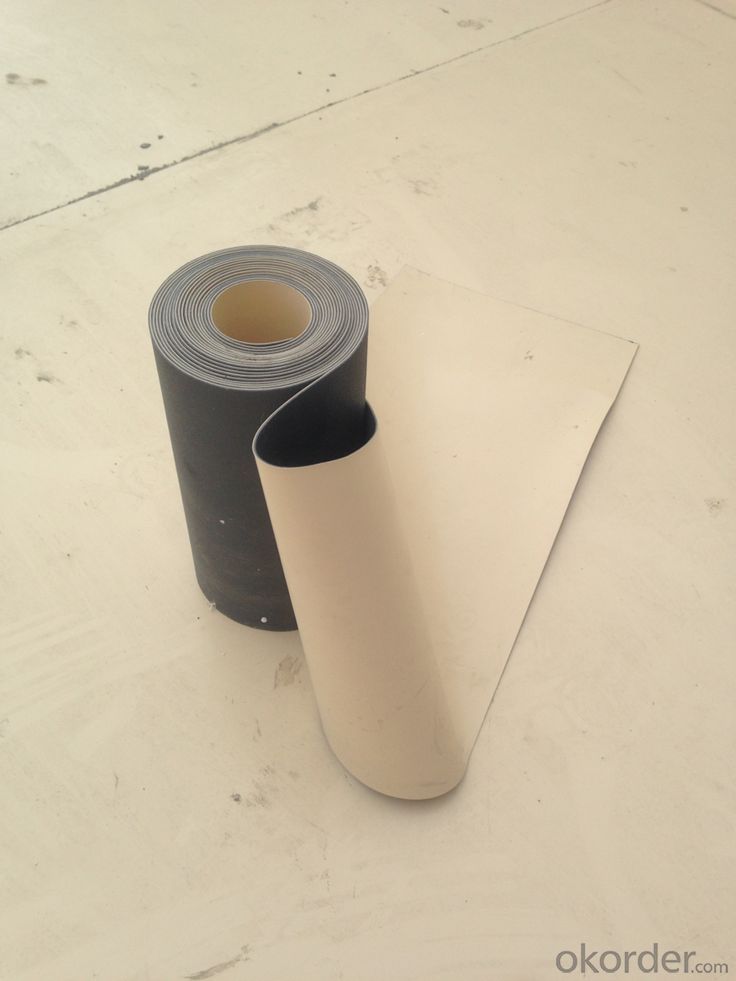
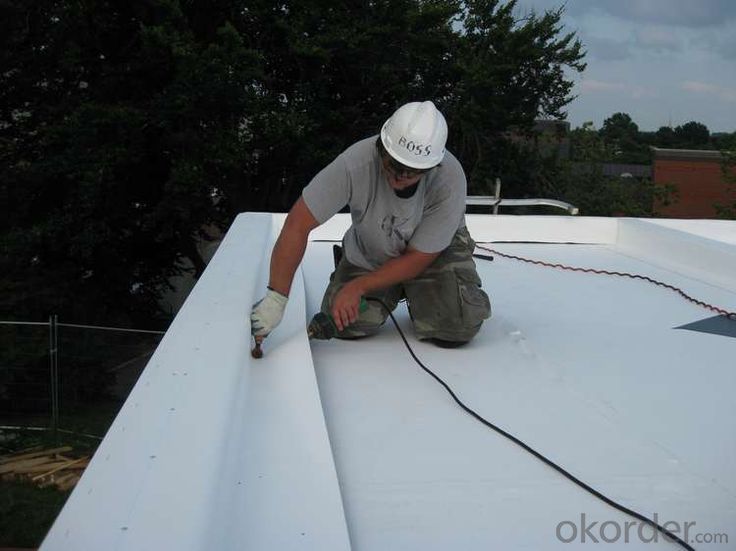
FAQ
Q: What's the delivery time ?
A: 3-5 days for 1-600 rolls, 10-15 days for container.
Q: What's the payment terms ?
A: TT/LC
Q: How do you make replacement with quality problems ?
A: New replacement will be packed into your next order or send to you directly after receive video or photo about quality problems.
- Q:Are waterproofing membranes resistant to alkalis?
- Waterproofing membranes, in general, exhibit resistance to alkalis. Alkalis, substances with high pH levels like sodium hydroxide or potassium hydroxide, can be present in various construction materials including concrete. The main purpose of waterproofing membranes is to create a protective barrier against water and other potentially harmful substances. They are typically manufactured using materials such as modified bitumen, PVC, or EPDM, which possess excellent alkali resistance. This resistance ensures that the waterproofing membrane remains intact and efficient even when exposed to alkaline substances. When dealing with materials or environments containing high levels of alkalis, it is crucial to choose a waterproofing membrane specifically designed for alkali resistance.
- Q:Can a waterproofing membrane be used for wastewater treatment plants or sewage facilities?
- Indeed, wastewater treatment plants and sewage facilities require protection against water infiltration and leakage due to the abundance of water and potentially corrosive substances. To address this issue, a versatile solution in the form of a waterproofing membrane can be utilized. This membrane acts as a barrier, preventing water penetration and safeguarding the structure from damage while ensuring the facility's proper functioning. Its application extends to various areas such as walls, floors, roofs, and tanks, effectively maintaining a watertight environment and prolonging the facility's lifespan. Moreover, certain waterproofing membranes are specifically engineered to withstand harsh chemicals, making them ideal for wastewater treatment plants and sewage facilities where corrosive substances may be present.
- Q:Can a waterproofing membrane be used for a school building foundation?
- Yes, a waterproofing membrane can be used for a school building foundation. Waterproofing membranes are designed to prevent water infiltration into structures, and they are commonly used in various construction applications, including building foundations. By installing a waterproofing membrane on the foundation walls, it can help to protect the building from water damage and prevent moisture-related issues such as mold, deterioration, and structural damage. This is particularly important for school buildings, as they often have extensive foundations and are subject to heavy usage and potential water exposure. Therefore, using a waterproofing membrane can be an effective solution to ensure the longevity and structural integrity of the school building foundation.
- Q:Can a waterproofing membrane be pre-fabricated or pre-made for easy installation?
- Yes, a waterproofing membrane can be pre-fabricated or pre-made for easy installation. In fact, many manufacturers offer pre-made waterproofing membranes that are specifically designed to simplify the installation process. These membranes are typically manufactured in controlled factory conditions, ensuring consistent quality and reducing the potential for errors during installation. Pre-fabricated waterproofing membranes are made from various materials such as bitumen, PVC, EPDM, or TPO, and come in different forms such as sheets or rolls. They are designed to be easily transported and installed on-site. The advantages of using pre-fabricated waterproofing membranes include increased efficiency, reduced labor costs, and improved installation quality. By eliminating the need for on-site fabrication, contractors can save time and resources. Additionally, pre-made membranes often come with detailed installation instructions, making it easier for contractors to ensure proper installation. Furthermore, pre-fabricated waterproofing membranes can be tailored to fit specific project requirements, such as size, shape, or slope. This customization helps to ensure a seamless and effective waterproofing solution. Overall, using pre-fabricated or pre-made waterproofing membranes can significantly simplify the installation process and provide a reliable and durable waterproofing solution for various applications, including roofs, basements, and foundations.
- Q:Is a waterproofing membrane resistant to hydrochloric acid or other corrosive substances?
- Waterproofing membranes are designed to resist water penetration and are commonly used as a barrier against moisture. However, it is important to understand that the resistance of a waterproofing membrane to hydrochloric acid or other corrosive substances may vary depending on the specific material used. Some waterproofing membranes, like those made from bituminous or rubberized asphalt materials, have a higher resistance to chemicals such as hydrochloric acid. These membranes are often utilized in industrial settings where exposure to corrosive substances is frequent. They are specifically engineered to endure the effects of these substances and offer long-lasting protection. On the contrary, other types of waterproofing membranes, such as those composed of polyvinyl chloride (PVC) or high-density polyethylene (HDPE), may have a lower resistance to corrosive substances like hydrochloric acid. These membranes are typically employed in less demanding applications where chemical exposure is not a significant concern. Regardless, it is essential to refer to the manufacturer's specifications and guidelines when assessing the resistance of a particular waterproofing membrane to hydrochloric acid or other corrosive substances. The manufacturer can provide detailed information on the membrane's chemical resistance properties and offer guidance on its suitability for specific applications involving corrosive substances.
- Q:Can a waterproofing membrane be used on rubber surfaces?
- Yes, a waterproofing membrane can be used on rubber surfaces. Waterproofing membranes are designed to create a barrier that prevents water from penetrating and damaging the underlying surface. Rubber surfaces, such as roofs, decks, or even rubber flooring, can benefit from the application of a waterproofing membrane to protect them from water damage. The membrane is typically applied as a liquid or a sheet, and it adheres to the rubber surface, forming a protective layer that prevents water from seeping through. This can help to extend the lifespan of the rubber surface and prevent issues such as leaks or decay caused by moisture. However, it is important to ensure that the waterproofing membrane is compatible with rubber and the specific type of rubber surface being treated, as some membranes may not adhere properly or may cause damage to certain types of rubber. It is always recommended to consult with a professional or the manufacturer of the waterproofing membrane to ensure proper application and compatibility.
- Q:Can a waterproofing membrane be exposed to extreme temperatures?
- In general, waterproofing membranes can handle extreme temperatures without any issue. These membranes are designed to endure a wide range of temperatures, including both high and low extremes. However, it's crucial to understand that the temperature limits and performance features may differ based on the membrane's type and brand. To ensure the membrane is suitable for the specific temperature conditions it will face, it is always recommended to consult the manufacturer's specifications and guidelines. Moreover, factors like UV exposure and thermal expansion/contraction should also be taken into account as they can impact the overall performance and lifespan of the waterproofing membrane in extreme temperature conditions.
- Q:Can a waterproofing membrane be used for a warehouse?
- Certainly, a warehouse can utilize a waterproofing membrane. This particular product is specifically designed to prevent the infiltration of water and safeguard structures from moisture-related harm. It can be applied to various surfaces, including concrete, metal, and wood, thereby making it suitable for warehouses constructed from diverse materials. By implementing a waterproofing membrane in a warehouse, several advantages can be obtained. Primarily, it aids in the prevention of water infiltration, which is especially vital in regions with heavy precipitation or in close proximity to bodies of water. By obstructing water from permeating the warehouse, it serves as a safeguard for the contents within, shielding them from water-induced damage such as rust, mold, and decay. Furthermore, a waterproofing membrane can enhance the overall structural integrity of the warehouse. Moisture has the potential to weaken the construction materials employed, leading to potential structural problems over time. By establishing a barrier against water, a waterproofing membrane can significantly prolong the lifespan of the warehouse and minimize the necessity for costly repairs. Moreover, a waterproofing membrane can also contribute to a healthier indoor environment within the warehouse. By thwarting water infiltration, it diminishes the risk of mold growth, which can be detrimental to air quality and the well-being of occupants. This is especially crucial if the warehouse stores delicate goods or if workers spend substantial amounts of time within the facility. To summarize, a warehouse can indeed incorporate a waterproofing membrane. It provides protection against water infiltration, enhances structural integrity, and contributes to a healthier indoor environment. The selection of an appropriate waterproofing membrane and ensuring its proper installation are critical in guaranteeing optimal performance and long-lasting protection for the warehouse.
- Q:Can a waterproofing membrane be used for an industrial facility?
- Yes, a waterproofing membrane can be used for an industrial facility. A waterproofing membrane is a protective layer that is applied to surfaces to prevent water penetration and moisture damage. Industrial facilities, such as manufacturing plants, warehouses, and processing plants, often require effective waterproofing to protect their structures, equipment, and inventory from water damage. Industrial facilities are often exposed to various sources of water, such as rain, leaks, or spills. These facilities may also have high humidity levels or water-intensive processes. Waterproofing membranes can provide a reliable barrier against water intrusion, helping to prevent damage and corrosion to the facility's structure, machinery, and products. Waterproofing membranes are designed to be durable and long-lasting, capable of withstanding harsh industrial conditions and high levels of traffic or heavy equipment. They are available in different materials, such as bitumen, PVC, EPDM, or polyurethane, allowing for flexibility in choosing the most suitable membrane for specific industrial applications. Furthermore, waterproofing membranes can also offer additional benefits beyond water resistance. Some membranes provide insulation properties, helping to regulate temperature and reduce energy consumption. They can also improve the overall safety and hygiene of an industrial facility by preventing the growth of mold, mildew, or bacteria that thrive in damp environments. In conclusion, a waterproofing membrane can be a highly effective solution for protecting an industrial facility from water damage. It provides a reliable barrier against water intrusion, ensuring the longevity and functionality of the facility, as well as protecting valuable assets within it.
- Q:Can a waterproofing membrane be applied in cold weather or during winter months?
- Yes, a waterproofing membrane can be applied in cold weather or during winter months. However, there are specific considerations and precautions that need to be taken into account. It is important to choose a waterproofing membrane that is specifically designed for cold weather applications. These membranes are formulated to withstand low temperatures and provide effective waterproofing even in freezing conditions. Before applying the membrane, the surface should be thoroughly cleaned and free from any debris, ice, or snow. It is also crucial to ensure that the surface is dry, as moisture can affect the adhesion and performance of the membrane. In cold weather, it may take longer for the surface to dry, so extra time should be allowed for this process. Additionally, the ambient temperature during the application should be within the recommended range specified by the manufacturer. Cold temperatures can affect the curing time of the membrane and may require longer curing periods. It is important to follow the manufacturer's instructions and guidelines for application and curing to ensure proper performance. Moreover, it is advisable to consult with a professional waterproofing contractor who has experience working in cold weather conditions. They can provide expert guidance and ensure that the membrane is applied correctly to achieve the desired waterproofing results. Overall, while it is possible to apply a waterproofing membrane in cold weather or during winter months, it is crucial to choose the right product, prepare the surface properly, and follow the manufacturer's instructions and guidelines to ensure a successful and effective application.
1. Manufacturer Overview |
|
|---|---|
| Location | |
| Year Established | |
| Annual Output Value | |
| Main Markets | |
| Company Certifications | |
2. Manufacturer Certificates |
|
|---|---|
| a) Certification Name | |
| Range | |
| Reference | |
| Validity Period | |
3. Manufacturer Capability |
|
|---|---|
| a)Trade Capacity | |
| Nearest Port | |
| Export Percentage | |
| No.of Employees in Trade Department | |
| Language Spoken: | |
| b)Factory Information | |
| Factory Size: | |
| No. of Production Lines | |
| Contract Manufacturing | |
| Product Price Range | |
Send your message to us
SBS Self-adhesive Bituminous Waterproof Roofing Membrane
- Loading Port:
- Shanghai
- Payment Terms:
- TT OR LC
- Min Order Qty:
- 44 roll
- Supply Capability:
- 100000 roll/month
OKorder Service Pledge
OKorder Financial Service
Similar products
New products
Hot products
Hot Searches
Related keywords
